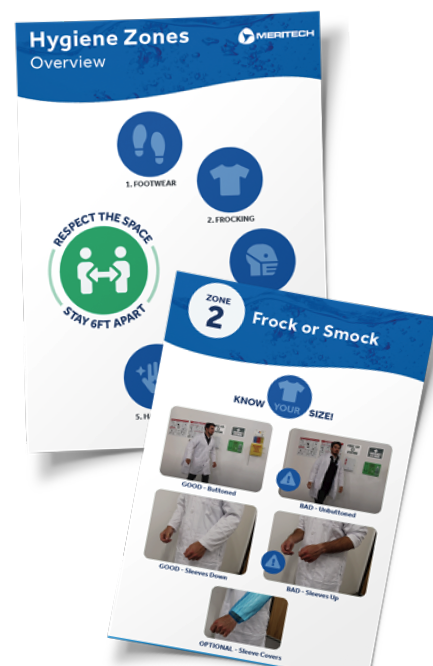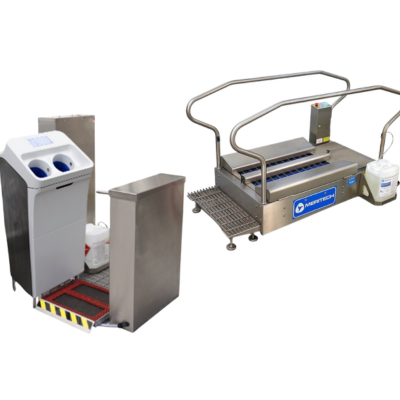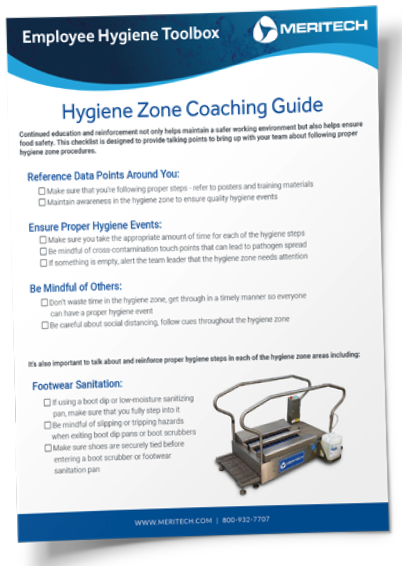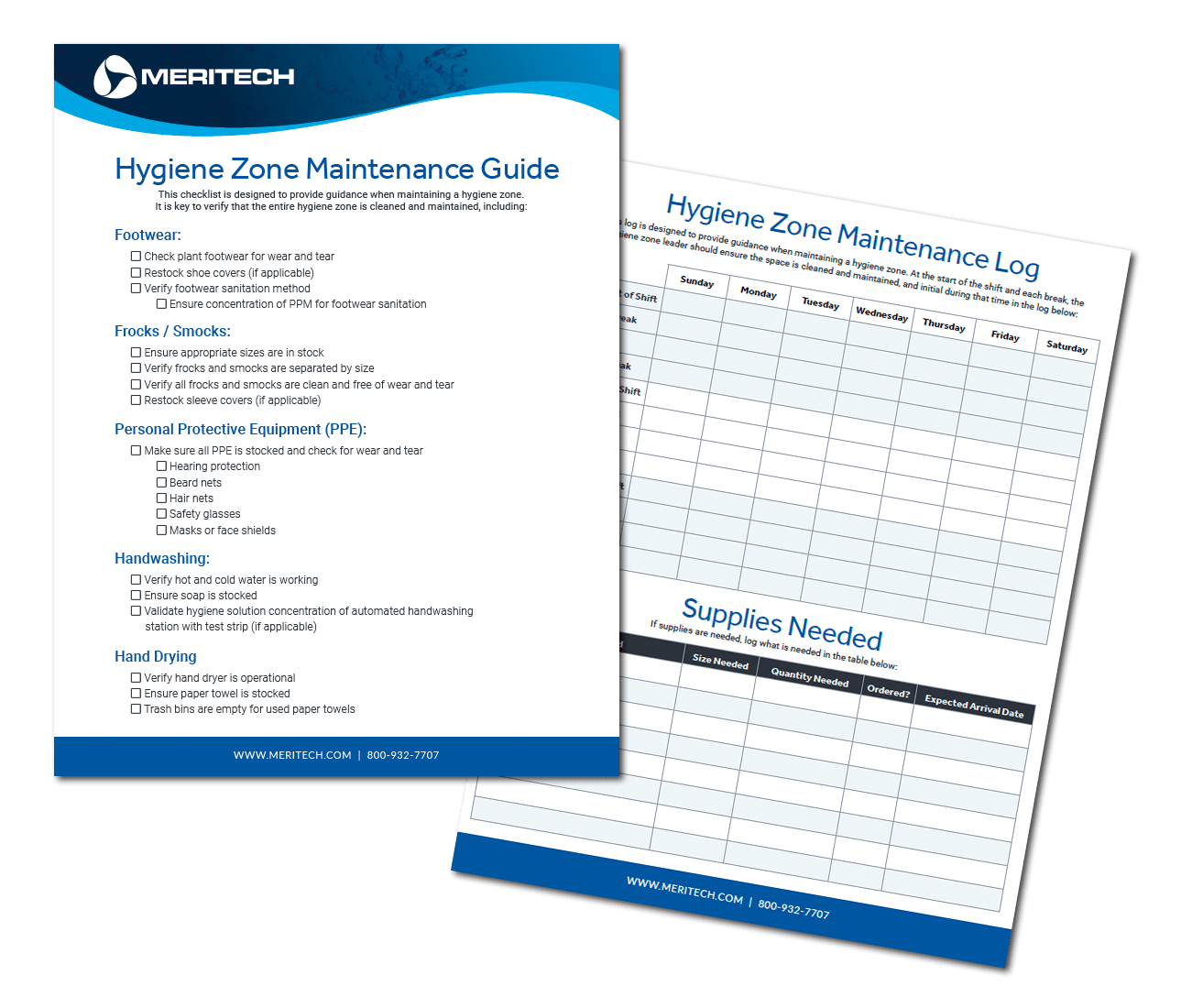Best Practices for Hygiene Stations in the Food Industry
Maintaining proper hygiene practices is crucial in the food industry, especially during the recent pandemic. Pathogens have always been a threat, so hygiene practices must be continuously prioritized. To ensure effective hygiene stations, it's crucial to monitor and guide team members on best practices through visual cues and automation. Consistently coaching and retraining employees creates a culture of hygiene excellence, while diligent maintenance and a designated hygiene zone leader ensure cleanliness and availability of supplies. This fosters a hygiene culture where employees adhere to best practices and uphold consumer safety.
Download our hygiene station eBook to learn more about hygienic zoning
Monitor and Guide Team Members on Hygiene Station Best Practices
 To ensure the effectiveness of hygiene practices, it is essential to constantly monitor them. As humans are prone to variability, some employees may take shortcuts during the 5 core steps, either intentionally or unintentionally. Human behavior plays a significant role in the spread of pathogens, making it crucial to address this variability. One effective approach is to utilize visual cues, such as posters, which provide valuable information to visitors and serve as reminders for team members about the proper procedures to follow in each area of the hygiene zone, including the correct order of the 5 core steps.
To ensure the effectiveness of hygiene practices, it is essential to constantly monitor them. As humans are prone to variability, some employees may take shortcuts during the 5 core steps, either intentionally or unintentionally. Human behavior plays a significant role in the spread of pathogens, making it crucial to address this variability. One effective approach is to utilize visual cues, such as posters, which provide valuable information to visitors and serve as reminders for team members about the proper procedures to follow in each area of the hygiene zone, including the correct order of the 5 core steps.
Download These Hygiene Posters to Help Guide Team Members on Hygiene Zone Steps
Use Automation Where Possible in the Hygiene Station

By implementing automatic handwashing stations or automated footwear sanitizing methods, you can enhance the efficiency of hygiene processes by eliminating the reliance on human behavior. This guarantees that employees will consistently maintain clean hands and footwear before accessing production areas.
Automated hygiene systems offer a multitude of benefits in today's fast-paced and hygiene-conscious world. Firstly, they optimize efficiency by minimizing human error in hygiene routines, ensuring consistent and meticulous cleanliness. These cutting-edge solutions also play a vital role in promoting public health by reducing the risk of cross-contamination and the spread of infectious diseases. Furthermore, automated hygiene systems save valuable time and resources by streamlining the hygiene process and reducing the need for constant human intervention.
Learn more about the benefits of automated hygiene!
Continually Coach and Retrain on Hygiene Station Processes
 Continual coaching and retraining on hygiene station processes in food processing facilities cannot be emphasized enough. Maintaining impeccable hygiene standards is crucial in this industry to safeguard the well-being of consumers and uphold the brand's reputation. Regular coaching and retraining of staff on hygiene station protocols are vital to reinforce best practices and keep employees informed about the latest industry standards and regulations. This helps foster a culture of accountability and diligence among workers, minimizing the risk of foodborne illnesses and product recalls. Moreover, ongoing training ensures that employees are proficient in utilizing the latest equipment and techniques for effective sanitation as new technologies and methods emerge. Ultimately, investing in continuous coaching and retraining not only ensures public health but also upholds the integrity of the food processing business and its commitment to delivering safe, high-quality products.
Continual coaching and retraining on hygiene station processes in food processing facilities cannot be emphasized enough. Maintaining impeccable hygiene standards is crucial in this industry to safeguard the well-being of consumers and uphold the brand's reputation. Regular coaching and retraining of staff on hygiene station protocols are vital to reinforce best practices and keep employees informed about the latest industry standards and regulations. This helps foster a culture of accountability and diligence among workers, minimizing the risk of foodborne illnesses and product recalls. Moreover, ongoing training ensures that employees are proficient in utilizing the latest equipment and techniques for effective sanitation as new technologies and methods emerge. Ultimately, investing in continuous coaching and retraining not only ensures public health but also upholds the integrity of the food processing business and its commitment to delivering safe, high-quality products.
Diligently Maintain the Hygiene Station
 Maintaining the hygiene zone goes beyond just establishing processes for team members to navigate through it. It is equally crucial to prioritize the upkeep of this area. With the increased importance of having the right personal protective equipment (PPE) and hygiene solutions readily available, it is essential to designate a hygiene zone leader for each shift. This responsible individual ensures that the hygiene zone remains clean and well-stocked at key intervals, including the start of the shift, during breaks, and at lunchtime. If any supplies are running low, it is the hygiene zone leader's responsibility to either order them or notify the appropriate person in charge of procurement.
Maintaining the hygiene zone goes beyond just establishing processes for team members to navigate through it. It is equally crucial to prioritize the upkeep of this area. With the increased importance of having the right personal protective equipment (PPE) and hygiene solutions readily available, it is essential to designate a hygiene zone leader for each shift. This responsible individual ensures that the hygiene zone remains clean and well-stocked at key intervals, including the start of the shift, during breaks, and at lunchtime. If any supplies are running low, it is the hygiene zone leader's responsibility to either order them or notify the appropriate person in charge of procurement.
Download the hygiene zone maintenance checklist seen above
to help your hygiene zone leader check the hygiene zone
Create a Hygiene Culture for the Hygiene Station
Establishing a hygiene zone leader to consistently check and maintain the hygiene zone is crucial. However, it is equally important to foster a culture of hygiene excellence within your team. In this environment, employees should feel empowered to not only adhere to hygiene best practices themselves but also hold others accountable. They should take responsibility for maintaining the cleanliness and availability of supplies in the hygiene zone. Every individual should recognize their role in upholding consumer safety and be motivated to follow proper procedures during each of the 5 hygiene zone steps, even when they are unsupervised.
Learn more about creating a hygiene culture at your facility in the Employee Hygiene Toolbox!







